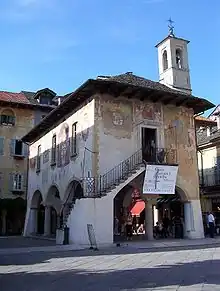
The broletto at Orta San Giulio, on Lake Orta
A broletto in medieval Italy communes was the place where the whole population met for democratic assemblies, and where the elected men lived and administered justice.[1]
Broletto is an ancient Italian word, from Medieval Latin "broilum, brogilum", which probably derives from a Celtic word. Its first meaning is "little orchard or garden"; hence the meaning "field surrounded by a wall".
Ancient broletti are major buildings in Milan, Brescia, Pavia, Piacenza, Como, Monza, Reggio Emilia, Novara and others. Several places or buildings in northern Italy are called "broletto".
List
- Broletto, Arona in Arona, province of Novara
- Palazzo della Ragione, Bergamo in Bergamo
- Broletto, Brescia
- Broletto, Como in Como
- In Cremona, two examples of broletti:
- the Guelph Palazzo Cittanova
- the Ghibelline Palazzo del Comune (Cremona)
- Broletto, Lodi in Lodi
- Palazzo del Podestà, Mantua
- In Milan:
- Palazzo della Ragione, Milan or Broletto Nuovo, one of three broletti
- Palazzo Carmagnola, formerly Broletto Nuovissimo, today hosting the Piccolo Teatro (Milan)
- Arengario (Monza)
- Broletto (Melegnano)
- Broletto, Novara in Novara
- Broletto, Orta or Palazzo della Comunità, in Orta San Giulio, province of Novara
- Broletto, Pavia in Pavia
- Broletto, Perugia in Perugia, current seat of the Umbria region
- Palazzo Comunale, Piacenza, or il Gotico
- Broletto, Reggio Emilia in Reggio Emilia
- Palazzo dell'Arengo (Rimini) in Rimini
- Palazzo Biumi and Palazzo Pretorio, Varese in Varese
See also
References
- ↑ "Broletto". Treccani (1930) (in Italian). Retrieved 2024-01-14.
This article is issued from Wikipedia. The text is licensed under Creative Commons - Attribution - Sharealike. Additional terms may apply for the media files.